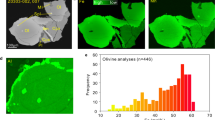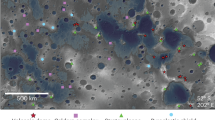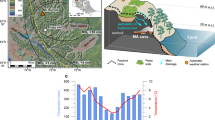Abstract
The majority of volcanic products on Mars are thought to be mafic and effusive1,2. Explosive eruptions of basic to ultrabasic chemistry are expected to be common3,4, but evidence for them is rare and mostly confined to very old surface features5. Here we present new image and topographic data from the High Resolution Stereo Camera that reveal previously unknown traces of an explosive eruption at 30° N and 149° E on the northwestern flank of the shield volcano Hecates Tholus. The eruption created a large, 10-km-diameter caldera ∼350 million years ago. We interpret these observations to mean that large-scale explosive volcanism on Mars was not confined to the planet's early evolution. We also show that glacial deposits partly fill the caldera and an adjacent depression. Their age, derived from crater counts, is about 5 to 24 million years. Climate models predict that near-surface ice is not stable at mid-latitudes today6, assuming a thermo-dynamic steady state. Therefore, the discovery of very young glacial features at Hecates Tholus suggests recent climate changes. We show that the absolute ages of these very recent glacial deposits correspond very well to a period of increased obliquity of the planet's rotational axis7.
This is a preview of subscription content, access via your institution
Access options
Subscribe to this journal
Receive 51 print issues and online access
$199.00 per year
only $3.90 per issue
Buy this article
- Purchase on Springer Link
- Instant access to full article PDF
Prices may be subject to local taxes which are calculated during checkout




Similar content being viewed by others
References
Greeley, R. & Spudis, P. D. Volcanism on Mars. Rev. Geophys. Space Phys. 19, 13–41 (1981)
Mouginis-Mark, P. J., Wilson, L. & Zuber, M. T. in Mars (eds Kieffer, H. H., Jakosky, B. M., Snyder, C. W. & Matthews, M. S.) 424–452 (Univ. Arizona Press, Tucson/London, 1992)
Francis, P. W. & Wood, C. A. Absence of silicic volcanism on Mars: Implications for crustal composition and volatile abundance. J. Geophys. Res. 87, 9881–9889 (1982)
Wilson, L. & Head, J. W. Mars: review and analysis of volcanic eruption theory and relationships to observed landforms. Rev. Geophys. 32, 221–263 (1994)
Greeley, R. & Crown, D. A. Volcanic geology of Tyrrhena Patera, Mars. J. Geophys. Res. 95, 7133–7149 (1993)
Mellon, M. T. & Jakosky, B. M. The distribution and behaviour of martian ground ice during past and present epochs. J. Geophys. Res. 100, 11781–11799 (1995)
Laskar, J. et al. Long term evolution and chaotic diffusion of the insolation quantities of Mars. Icarus 170, 343–364 (2004)
Neukum, G. et al. HRSC: The High Resolution Stereo Camera of Mars Express 17–35 (Report ESA-SP-1240, European Space Agency Publications Division, Noordwijk, The Netherlands, 2004)
Mouginis-Mark, P. J., Wilson, L. & Head, J. W. Explosive Volcanism on Hecates Tholus, Mars: Investigation of Eruption Conditions. J. Geophys. Res. 87, 9890–9904 (1982)
Wewel, F., Scholten, F. & Gwinner, K. High Resolution Stereo Camera (HRSC)—Multispectral 3D-data aquisition and photogrammetric data processing. Can. J. Remote Sens. 26, 466–474 (2000)
Werner, S. C., Ivanov, B. A. & Neukum, G. Impact cratering on Mars: Search for target influence on morphology. Lunar Planet. Sci. XXXV, abstr. 1953 [CD-ROM] (Lunar and Planetary Institute, Houston, 2004)
Gulick, V. C. & Baker, V. R. Origin and evolution of valleys on martian volcanoes. J. Geophys. Res. 95, 14325–14344 (1990)
Hartmann, W. K. & Neukum, G. Cratering chronology and the evolution of Mars. Space Sci. Rev. 96, 165–194 (2001)
Neukum, G. et al. Mars: Recent and episodic volcanic and glacial activity on Mars revealed by the High Resolution Stereo Camera. Nature 432, 971–979 (2004)
Squyres, S. W. Martian fretted terrain: flow of erosional debris. Icarus 34, 600–613 (1978)
Mangold, N. Geomorphic analysis of lobate debris aprons on Mars at Mars Orbiter Camera scale: Evidence for ice sublimation initiated by fractures. J. Geophys. Res. 108, 8021, doi:10.1029/2002JE001885 (2003)
Baker, V. R. Water and the martian landscape. Nature 412, 228–236 (2001)
Wall, S. W. Analysis of condensates formed at the Viking 2 Lander site: The first winter. Icarus 47, 173–183 (1981)
Head, J. W. & Marchant, D. R. Cold-based mountain glaciers on Mars: Western Arsia Mons. Geology 31, 641–644 (2003)
Head, J. W., Mustard, J. F., Kreslavsky, A., Milliken, R. E. & Marchant, D. R. Recent ice ages on Mars. Nature 426, 797–802 (2003)
Mitrofanov, I. et al. Maps of subsurface hydrogen from the high-energy neutron detector, Mars Odyssey. Science 297, 78–81 (2002)
Feldman, W. C. et al. Global distribution of near-surface hydrogen on Mars. J. Geophys. Res. 109, E09006, doi:10.1029/2003JE002160 (2004)
Jakosky, B. M., Henderson, B. G. & Mellon, M. T. Chaotic obliquity and the nature of the martian climate. J. Geophys. Res. 100, 1579–1584 (1995)
Levrard, B., Forget, F., Montmessin, F. & Laskar, J. Recent ice-rich deposits formed at high latitudes on Mars by sublimation of unstable equatorial ice during low obliquity. Nature 431, 1072–1075 (2004)
Mischna, M. A., Richardson, M. I., Wilson, R. J. & McCleese, D. J. On the orbital forcing of martian water and CO2 cycles: A general circulation model study with simplified volatile schemes. J. Geophys. Res. 108, 5062, doi:10.1029/2003JE002051 (2003)
Haberle, R. M., Murphy, J. R. & Schaeffer, J. Orbital change experiments with a Mars general circulation model. Icarus 161, 66–89 (2003)
Skorov, Y. V. et al. Stability of water ice under a porous nonvolatile layer: implications to the south polar layered deposits of Mars. Planet. Space Sci. 49, 59–63 (2001)
Marchant, D. R. et al. Formation of patterned ground and sublimation till over Miocene glacier ice in Beacon Valley, southern Victoria Land, Antarctica. Geol. Soc. Am. Bull. 114, 718–730 (2002)
Mellon, M. T., Jakosky, B. M. & Postawko, S. E. The persistence of equatorial ground ice on Mars. J. Geophys. Res. 102, 19357–19369 (1997)
Helbert, J. & Benkhoff, J. A new model on the thermal behavior of the near surface layer on Mars and its implications for ground ice deposits in Gusev Crater. 6th Int. Conf. Mars abstr. 3019 [CD-ROM] (Lunar and Planetary Institute, Houston, 2003)
Acknowledgements
We thank the entire HRSC experiment and instrument teams at the German Aerospace Center (DLR) and at the Freie Universität Berlin, as well as the Mars Express teams at ESTEC and ESOC. This study would not have been possible without their work. In particular, we appreciate the support of H. Hoffmann, T. Roatsch, K.-D. Matz, V. Mertens, J. Flohrer, R. Pischel, F. Scholten and K. Gwinner. HRSC was developed at DLR and industrial partners. G.N. is the Principal Investigator of this experiment. We are grateful to U. Wolf for her support in crater counting. M. Aittola, J. Korteniemi, P. Kostama and D. Williams supported the HRSC image planning. T. Lowell provided an image of his collection of glacier photographs. Comments by J. Helbert helped to improve the manuscript.
Author information
Authors and Affiliations
Consortia
Corresponding author
Ethics declarations
Competing interests
The authors declare that they have no competing financial interests.
Additional information
A list of all members of The HRSC Co-Investigator Team and their affiliations appears at the end of the paper
Rights and permissions
About this article
Cite this article
Hauber, E., van Gasselt, S., Ivanov, B. et al. Discovery of a flank caldera and very young glacial activity at Hecates Tholus, Mars. Nature 434, 356–361 (2005). https://doi.org/10.1038/nature03423
Received:
Accepted:
Issue Date:
DOI: https://doi.org/10.1038/nature03423
This article is cited by
-
Volcanic craters and cones in central Kachchh mainland, western India: Potential analogue for the Martian studies?
Journal of Earth System Science (2022)
-
Mars: a small terrestrial planet
The Astronomy and Astrophysics Review (2016)
-
Long-Term Evolution of the Martian Crust-Mantle System
Space Science Reviews (2013)
Comments
By submitting a comment you agree to abide by our Terms and Community Guidelines. If you find something abusive or that does not comply with our terms or guidelines please flag it as inappropriate.



